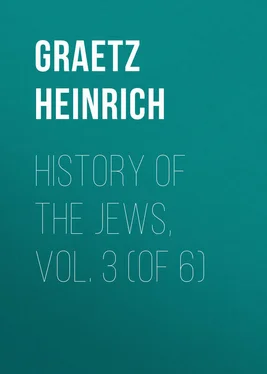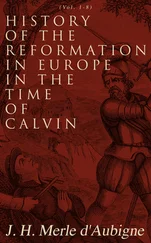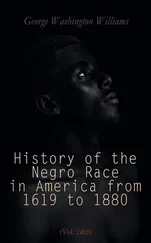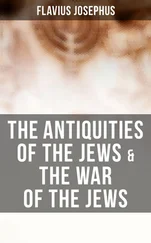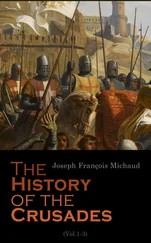Heinrich Graetz - History of the Jews, Vol. 3 (of 6)
Здесь есть возможность читать онлайн «Heinrich Graetz - History of the Jews, Vol. 3 (of 6)» — ознакомительный отрывок электронной книги совершенно бесплатно, а после прочтения отрывка купить полную версию. В некоторых случаях можно слушать аудио, скачать через торрент в формате fb2 и присутствует краткое содержание. Жанр: История, foreign_antique, foreign_prose, на английском языке. Описание произведения, (предисловие) а так же отзывы посетителей доступны на портале библиотеки ЛибКат.
- Название:History of the Jews, Vol. 3 (of 6)
- Автор:
- Жанр:
- Год:неизвестен
- ISBN:нет данных
- Рейтинг книги:3 / 5. Голосов: 1
-
Избранное:Добавить в избранное
- Отзывы:
-
Ваша оценка:
- 60
- 1
- 2
- 3
- 4
- 5
History of the Jews, Vol. 3 (of 6): краткое содержание, описание и аннотация
Предлагаем к чтению аннотацию, описание, краткое содержание или предисловие (зависит от того, что написал сам автор книги «History of the Jews, Vol. 3 (of 6)»). Если вы не нашли необходимую информацию о книге — напишите в комментариях, мы постараемся отыскать её.
History of the Jews, Vol. 3 (of 6) — читать онлайн ознакомительный отрывок
Ниже представлен текст книги, разбитый по страницам. Система сохранения места последней прочитанной страницы, позволяет с удобством читать онлайн бесплатно книгу «History of the Jews, Vol. 3 (of 6)», без необходимости каждый раз заново искать на чём Вы остановились. Поставьте закладку, и сможете в любой момент перейти на страницу, на которой закончили чтение.
Интервал:
Закладка:
The enthusiasm of the Arabs for their language and the Koran evoked in the hearts of the Jews a similar sentiment for the Hebrew tongue and its holy records. Besides this, the Jews were now obliged to make closer acquaintance with the Scriptures, in order that they might not be put to the blush in their controversies with the Mahometans. Until now the talented men among them had turned their attention exclusively to the Talmud and the Agadic exposition, but necessity at last compelled them to return to the source, the Bible.
As soon, however, as it was desired to recover what had been lost for centuries, and to return with ardor to the study of Biblical literature, a need manifested itself which first had to be supplied. In supplying the Biblical text with the vowel signs invented in Babylonia or in Tiberias, it was necessary to proceed in such passages, as had not become familiar by frequent reading in public, according to grammatical rules. The Punctuators were obliged to be guided partly by tradition and partly by their sense of language. In this manner there arose the rudiments of two branches of knowledge: one treating of the above-mentioned rules of the Hebrew language, the other of the science of orthography, together with the exceptions as handed down by tradition (Massora). This apparently unimportant invention of adding certain strokes and points to the consonants thus led to the comprehension of the Holy Scriptures by the general public and the initiation of a more general knowledge of Judaism. By its help the holy language could now celebrate its revival; it was no longer a dead language employed only by scholars, but might become a means of educating the people. The auxiliary signs tended to break down the barrier between the learned (Chacham) and the unlearned (Am-ha-Arez).
An immediate consequence of contact with the Arabs and the study of the Holy Writ was the birth of neo-Hebraic poetry. Poetical natures naturally felt themselves impelled to make use of the copious Hebrew vocabulary in metrical compositions and polished verse, in the same manner as the Arabs had done with their language. But while the Arabic bards sang of the sword, of chivalry, of unbridled love, bewailed the loss of worldly possessions, and attacked with their satire such of their enemies as they could not reach with the sword, the newly-awakened Hebrew poetry knew of but one subject worthy of enthusiasm and adoration, God and His providence, of but one subject worthy of lament, the destitution and sorrows of the Jewish nation. The new-born Hebrew poetry, however different in form and matter from that of the Bible, had a religious foundation in common with it. The psalm of praise and the soul-afflicting dirge of lamentation were taken by the neo-Hebraic poets as their models. But a third element also claimed attention. Since the state had lost its independence, learning had become the soul of Judaism; religious deeds, if not accompanied by knowledge of the Law, were accounted of no worth. The main feature of the Sabbath and festival services was the reading of portions of the Law and the Prophets, the interpretation thereof by the Targumists and the explanation of the text by the Agadists (preachers of homilies). Neo-Hebraic poetry, if it was to reach the hearts of the people, could not be entirely devoid of a didactic element. The poet's only scene of action was the synagogue, his only audience, the congregation assembled for prayer and instruction, and his poetry, therefore, necessarily assumed a synagogical or liturgical character.
The poetical impulse was strengthened by practical necessity. The original divine service with its short and simple prayers was no longer sufficient. It was extended, it is true, by the recitation of psalms and appropriate liturgical compositions, but even this did not fill up the time which the congregation would gladly have spent in the house of God. This was especially felt on the New Year's festival and on the Day of Atonement, which were dedicated to deep devotion, and during the greater part of which the congregation remained in the house of prayer, contrite, and imploring forgiveness and redemption. It was evident that the divine service must be amplified, and more matter for meditation provided. In this manner arose the synagogical, or, as it was also called, the poetanic composition. At the head of the succession of neo-Hebraic poets stands José bar José Hayathom (or Haithom), whose works are not without true poetic ring, although devoid of artistic form. The date and nationality of this poet are entirely unknown, but it appears probable that he was a native of Palestine, and that he lived not earlier than the first Gaonic century.
José b. José took as the subject of his poems the emotions and memories which move a Jewish congregation on New Year's Day. On this occasion, the birthday of a new division of time, on which, according to Jewish ideas, the fate that the year has in store for men and communities is decided, God is extolled in a sublime poem as the mighty Master, the Creator of the world, the just Judge and the Redeemer of Israel. This poem, which was attached to the old prayers for the prescribed blowing of the cornet, and was intended to interpret them, embraces in a small compass the story of Israel's glorious past, its oppressed present, and promised future. José's poem is at once a psalm of triumph and of lamentation, interwoven with penitential prayers and words of hope. The resurrection is described in a few striking, picturesque lines.
Another and longer of José's poems has for its theme the ancient worship in the Temple on the Day of Atonement, which an attentive nation had once followed in devotional mood, and the description of which was well calculated to awaken the great memories of the glorious times of national independence (Abodah). It is a sort of liturgical epic, which describes simply, and without any lyrical strain, the creation of the universe and of man, the ungodliness of the first generation, Abraham's recognition of God, the election of his posterity as God's peculiar people, and the calling of Aaron's family to the service of the Temple. Arrived at the priesthood of Aaron, the poet, following the account of the Mishna, goes on to describe the duties of the high-priest in the Temple on the Day of Atonement, and concludes with the moment when the high-priest, accompanied by the whole nation, joyful and assured by visible signs of forgiveness, leaves the Temple for his home, – a beautiful fragment of the past, which has always awakened a powerful echo in the hearts of the Jewish people.
Elevation of thought and beauty of language are the characteristics of José b. José's poetry. His New Year's sonnets and Temple epic have become parts of the divine service of certain congregations, and have served as models for others. His verses are unrhymed and without meter, a proof of their great antiquity. The only artificial feature of his poetical works is the alphabetical or acrostic commencement of verses, for which several of the Psalms, Jeremiah's Lamentations, and the post-talmudical prayers served as models. In the first fruits of the new Hebraic poetry, form is completely subservient to the subject-matter. There has been preserved from ancient times another Abodah, ascribed to a poet named Simon ben Caipha. It appears to have been written in imitation of that of José b. José, but is greatly inferior to its model. However, it was honored by being adopted by the synagogue of the Gaonate. To the name of Simon Caipha, which sounds like the Jewish name of the apostle Peter, a peculiar legend is attached: The apostle, who supports the foundation of the Catholic Church, is represented as having written this Abodah in order to declare in the opening part his truly Jewish acknowledgment of God's unity, and to renounce his adherence to Jesus, as though the disciple who three times denied his Master had desired in this liturgical poem to attest his unbelief.
Читать дальшеИнтервал:
Закладка:
Похожие книги на «History of the Jews, Vol. 3 (of 6)»
Представляем Вашему вниманию похожие книги на «History of the Jews, Vol. 3 (of 6)» списком для выбора. Мы отобрали схожую по названию и смыслу литературу в надежде предоставить читателям больше вариантов отыскать новые, интересные, ещё непрочитанные произведения.
Обсуждение, отзывы о книге «History of the Jews, Vol. 3 (of 6)» и просто собственные мнения читателей. Оставьте ваши комментарии, напишите, что Вы думаете о произведении, его смысле или главных героях. Укажите что конкретно понравилось, а что нет, и почему Вы так считаете.
